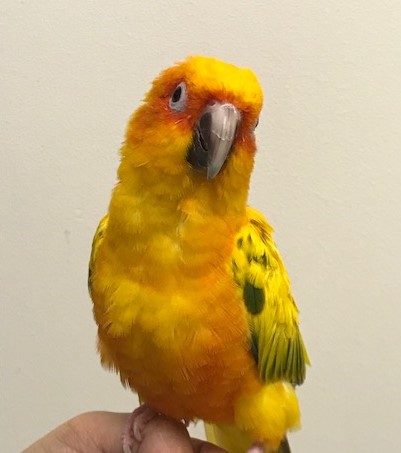
It may be cold today in Toronto, but it’s a bright and sunny day as January draws to a close. So it seems apropos that we are saying goodbye (for now) to the bright and brilliant sun conure as our Animal of the Month. We hope you enjoyed our tweets about these loud birds while following us on Twitter @ExoticPetVets. If you missed any of our tweets, here is a summary that you can reference any time – and you won’t even need earplugs! Did you know?:
- The sun conure (Aratinga solstitialis) is a brightly-coloured small parrot species endemic to South America.
- What’s in a name? In the case of sun conures, their scientific name is rather literal. In Latin, Aratinga means “little macaw” while solstitialis means “of the summer solstice.” The summer solstice is the one day of the year that has the most daylight.
- Wild sun conures can be found in a tiny corner of northeastern South America; specifically, in the northern Brazilian state of Roraima and southern Guyana.
- Depending on the source, there is some debate on whether sun conures are currently found in the southern parts of Suriname and French Guiana. There have also been some unconfirmed sightings in Venezuela.
- The sun conure is endangered and its wild population is decreasing. The IUCN Red List
estimates that there are only 1,000-2,499 mature individuals left in the wild. - The wild sun conure population is being decimated by human activity; namely, habitat loss and trapping for the pet trade.
- Sun conures in the wild will live in savanna and coastal forests as well as in palm groves. Their diet includes seeds, fruits, berries, insects and nuts.
- Sun conures are very social and will live in tight-knit flocks of up to 30 birds.
- The University of Michigan’s Museum of Zoology says wild sun conures are still a bit of a mystery because they live in undeveloped areas which makes them difficult to study in their natural habitats.
- Compared to some other parrot species, sun conures are small. Adults measure 12 inches (30 cms) tip-to-tail and have an average weight of about 110 grams.
- The sun conure’s physical appearance looks like a sunny summer’s day. They are bright yellow and orange with brilliant green and deep blue feathers on their wings and tails.
- Sun conures have black beaks and a long tapered tail. They also have rings of bare white skin around their dark eyes.
- Female and male sun conures look very similar to each other. Males and females may have subtle differences in appearance (for example, females may have slightly shorter tails), but overall it is not easy to tell them apart just by looking at them.
- It takes a while for sun conures to grow into their brilliant plumage. Juveniles are duller in colour and have more green feathers. They won’t develop their bright adult feathers until they are between 18-months to two-years of age.
- Sun conures seem to have two volumes – loud and louder. With their ear-piercing shrieks, they are considered to be among the loudest parrot species on the planet.
- Sun conures are loud by design because they need loud calls in the wild in order to locate and communicate with each other across far distances.
- Some sources suggest that sun conure shrieks can reach as high as 120 decibels – comparable to the noise level of sirens, airplanes and jackhammers according to the Johns Hopkins University School of Medicine in Baltimore.
- Because they are so loud, sun conures are not a good choice of avian companions for apartment and condo dwellers or for people who are sensitive to loud noise.
- Even though they are a parrot species, sun conures in captivity are not really known for their ability to mimic human speech with the same proficiency as macaws and Amazon parrots.
- Some sun conures are able to learn a few words and simple phrases, while others would rather mimic everyday sounds heard in their homes (beeping appliances, doorbells, etc.).
- While sun conures in captivity can mimic human speech or sounds, it doesn’t mean they will. Many prefer to do neither and will only vocalize as they would normally out in the wild.
- Because of the challenges of studying wild sun conures in their natural habitats, their average lifespan is unclear. But it’s believed to be shorter than captive birds because of the everyday perils of living in the wild.
- In captivity, sun conures can live between 15-25 years on average with proper care.
- Did you know that the Carnegie Museum of Natural History in Pittsburgh has a resident sun conure named Mango? Mango was rescued from a hoarding situation before his life at the museum.
- Sun conures, like other parrots, enjoy music and the Carnegie Museum of Natural History says Mango will sing and dance while listening to music. The museum says Mango’s favourite artists include Taylor Swift and Bon Jovi!

